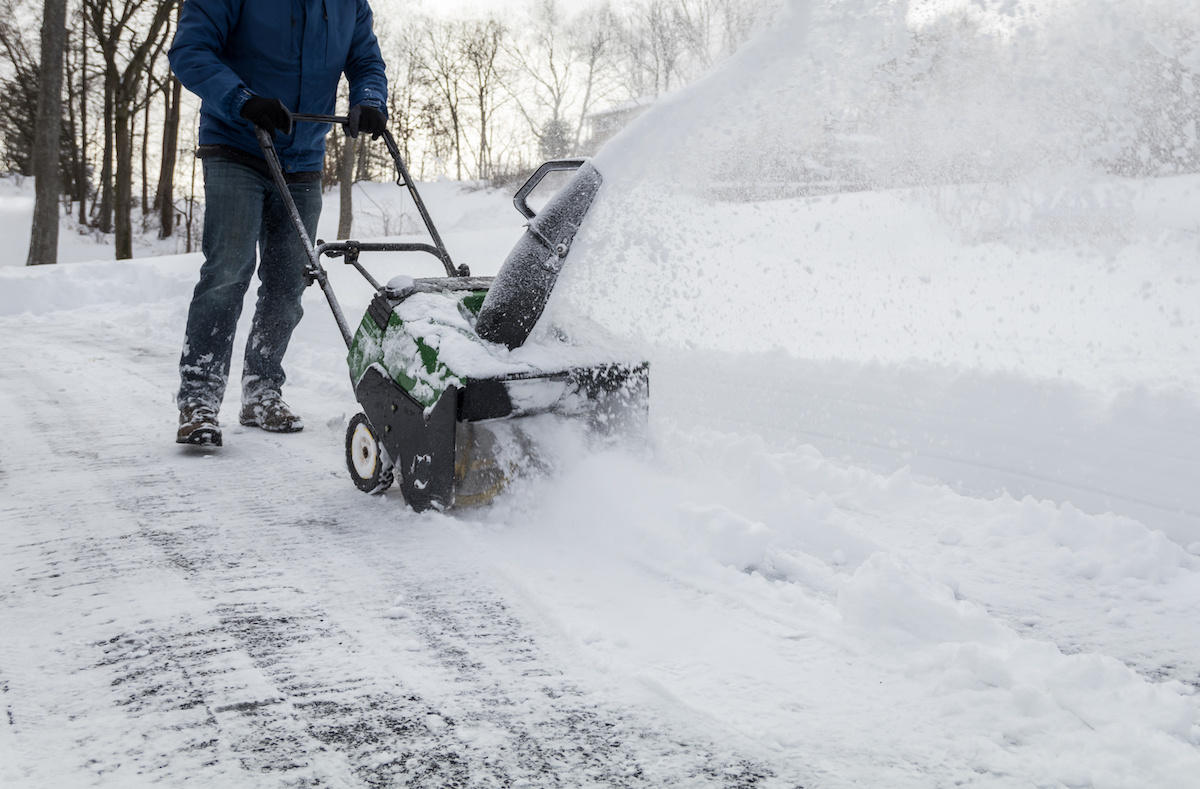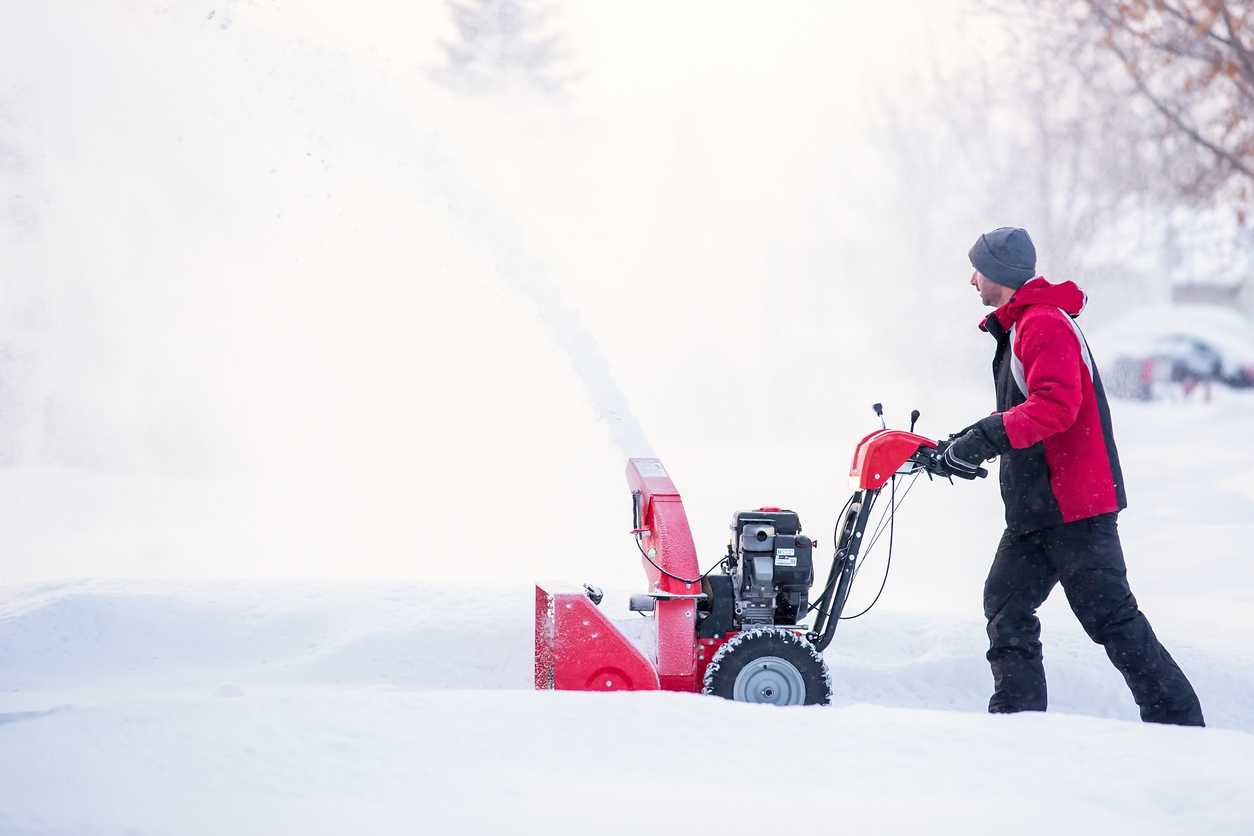

We may earn revenue from the products available on this page and participate in affiliate programs. Learn More ›
Today’s snow removal machines make quick work of clearing the white stuff from driveways and sidewalks—saving your back from the strain of shoveling and tossing aside heavy snow. Yet while the terms “snow blower” and “snow thrower” are often used interchangeably (even by manufacturers at times), the two machines are actually quite dissimilar in terms of power, functionality, and price. We’ve put these two side by side—snow blower vs. snow thrower—to identify six notable differences. Keep reading to find out which snow removal machine is best suited to your climate, property, and budget.
A snow blower is more powerful than a snow thrower.
A snow thrower is single-stage machine, meaning it gathers snow and tosses it out a chute in a single motion. The power generated by a horizontal spinning auger picks up the snow while also creating the force that expels snow out of a discharge chute, usually to a distance of 15 to 25 feet away.
A snow blower works in two stages; like a snow thrower, it has a rotating auger to scoop up snow, but the snow is then fed into an impeller, which is akin to a powerful fan that launches the snow up to 35 feet away, or farther. At the even more powerful end of the snow blower spectrum are three-stage blowers that feature accelerators that chew through hard-packed snow and even ice, crushing it and feeding it into a mighty impeller that can launch snow up to 50 feet away.

RELATED: We Tested 2025’s Best Single-Stage Snow Blowers and Found 9 Top Models You Can Rely On
Two-stage snow blowers remove a wider swath in one pass than single-stage snow throwers.
Single-stage snow throwers are on the smaller side, and they remove snow in swath widths between 11 inches and 22 inches, depending on the individual machine. Two-stage snow blowers can clear up to a 26-inch swath of snow, while three-stage snow blowers can remove as much as 30 inches of snow in a single swath. In areas that get frequent snows, a snow blower that removes a wider swath will significantly reduce the amount of time spent clearing away snow.
Snow throwers work better with light snow accumulations.
Because they’re smaller and less powerful than snow blowers, snow throwers are better suited to removing light snow accumulations of about eight to nine inches, maximum. The top of the front intake chute on a snow blower is higher than it is on a snow thrower, so snow blowers can tackle deeper drifts and accumulations of 15 inches or more. In addition, small snow throwers are often not self-propelled, which also makes it more difficult for the operator to physically push them in thicker snow accumulations. The majority of snow blowers on the market today are self-propelled.
Snow blowers are usually fuel-powered.
Single-stage snow throwers are often powered by an extension cord, which limits their use to the length of the cord and requires access to an electrical outlet. Some newer snow throwers are powered by rechargeable lithium-ion batteries, so they are not limited by distance, and they will run 20 to 45 minutes on a single battery charge. Snow blowers, on the other hand, are usually powered by gasoline or diesel, so they’re not restricted by the length of a cord and allow the user to clear snow until they run out fuel.

Snow throwers are easier to store and maintain.
Corded and battery-operated snow throwers tend to be smaller machines that don’t take up much room in a garage or shed, whereas some gas-powered two- and three-stage snow blowers are nearly as large as a garden tractor and require ample room for storage. Because they don’t use fuel, battery-operated and corded snow throwers don’t require the storage of flammable gasoline (nor do they don’t create fumes while in use). Plus, a gas-powered engine must be regularly maintained, which includes checking and adding oil when necessary and changing the gas filter and spark plug annually.
RELATED: Snow Blower Won’t Start? Try These Troubleshooting Tips
Snow throwers cost less but come with fewer options.
As with most types of machines, as the price ticks up, so do the bells and whistles. Check out some of the most common options for each type of snow thrower and snow blower.
Corded electric snow throwers:
- Prices start around $100 for small basic models with a simple ON/OFF switch and can run as high as $300 for larger models that feature a headlight and a more powerful motor.
- Some (not all) corded electric snow throwers come with a “dead man’s” release that shuts off the motor if the user lets go of the trigger. Others must be manually switched to OFF.
- Padded comfort grips are included on most corded snow throwers.
Battery-operated snow throwers:
- Prices start around $250 for a 40-volt model (battery not included) and run as much as $900 for a 100-volt thrower that comes with two batteries to lengthen runtime without recharging.
- At the mid- and higher-end, battery-operated snow throwers boast headlights, a dead man’s release, and padded comfort grips.

Single-stage gas-powered snow throwers:
- Prices range from $300 to $750, based on size and engine power.
- At the cheaper end, expect a manual crank that requires you to pull a cord to start the engine. For around $450 and up, you can find throwers with a push-button start and headlights.
- Most single-stage gas throwers come with a dead man’s release and the ability to vary operating speed, as you can with a gas-powered lawnmower.
Some models are self-propelled and most come with padded comfort grips.
Two-stage gas-powered snow blowers:
- Prices run from $600 to $2,000 or more and virtually all two-stage snow blowers come with electric start buttons and are self-propelled.
- As prices increase, expect to find options that improve maneuverability, such as a joystick lever that allows the user to steer the blower easily.
- Virtually all two-stage snow blowers include headlights and a dead man releases, and most come with padded comfort grips and variable speed options.
- Some models feature heated grips.
Three-stage gas-power snow blowers:
- With the addition of an accelerator, you can expect to pay from $1,000 to $2,500 or more for a three-stage snow blower.
- All models come with electric start buttons and are self-propelled.
- Most feature power steering options and many come with heated comfort grips.
- Some three-stage snow blowers feature track drives (think of a bulldozer) instead of wheels, which gives the machine more traction and reduces slipping on packed snow and icy surfaces.
